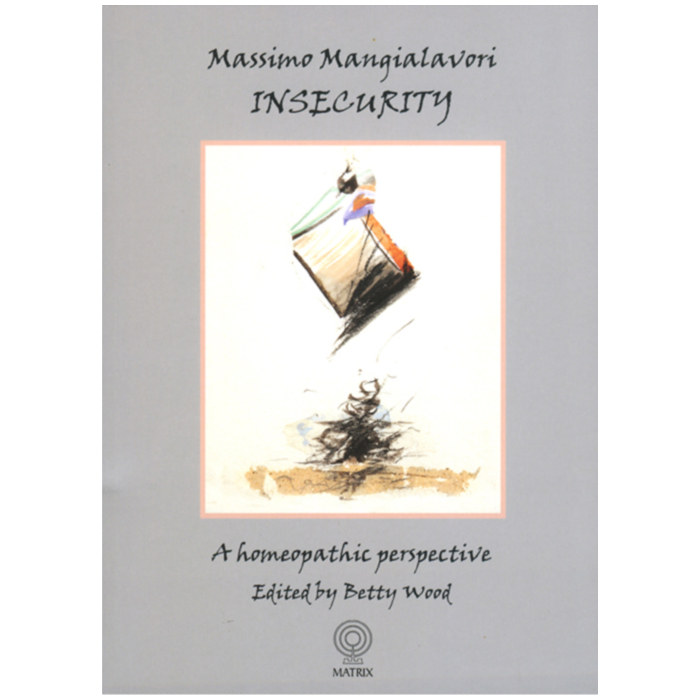OUT OF PRINT: Insecurity: A Homeopathic Perspective
Share on social media
Edited by Betty Wood
| ISBN | 9788888799155 |
|---|---|
| Author | Massimo Mangialavori |
| Type | Paperback |
| Language | English |
| Publication date | 2008-01-01 |
| Pages | 459 |
| Publisher | Matrix |
| Review | This book review is reprinted with the permission from the Autumn 2009 Edition of The Homeopath. Reviewed by Nick Churchill This book is an edited transcript of a seminar given to the postgraduate course of the Koine School in Bologna in October 2006, on the theme 'Insecurity', in all its different forms. Until lately, Dr Mangialavori has always taught homeopathy through families of related remedies. With the postgraduate course came a turning point. Now his approach is to teach remedies through what he calls the 'archetypal themes' - the big, universal issues that all of us face in our life - and the remedies or families of remedies that tend to suffer from one or other of these issues most strongly. He studies the theme initially through the two families of remedies of which it is most characteristic - the Aluminas, the Barytas and their various salts. His in-depth knowledge of small, often tiny remedies - as well as some that are almost unheard of furnishes many other remedies that have insecurity as a fundamental theme. It is worth reading this book just for the chance to mine these gems for example: Abelmoschus, Aconite, Daphne indica, Epiphegus, GossYPium, Magnetis polus australis, Pulmo vulpis, Saccharum album, Tabacum and Thallium metallicum, presented with a general discussion about how the patients look, behave, what problems and issues they have, and at what point in their life they are likely to decompensate and fall ill. Massimo explains in detail how he studies remedies and developed his ideas and how we can apply them. The approach to this subject is rigorous and thorough. It starts with a discussion of what insecurity means and all the different ways in which it can manifest - behaviourally, through physical symptoms, plus how the patient may try to compensate for it. There follows an examination of the concept of 'narcissism' - healthy when in balance but missing or exaggerated in insecure patients, and of the origins of insecurity. He gathers together coherent groups of symptoms found in the repertory that express different aspects of insecurity; rubrics around such issues as 'anticipation', 'timidity', 'avoidance', and more. Included is a discussion of the so-called 'Method of Complexity', for which you need to read the book. Mangialavori has seen it all before, and a quiet compassion and wisdom shine through this book. Betty Wood has done a great job of editing the text and smoothing out the occasional idiosyncrasies of Italian English. I did not attend this seminar myself and so am grateful to them both. This book originates from a seminar transcript; we can feel like we ourselves are right there in the classroom with the teacher. |
Review
This book review is reprinted with the permission from the Autumn 2009 Edition of The Homeopath.
Reviewed by Nick Churchill
This book is an edited transcript of a seminar given to the postgraduate course of the Koine School in Bologna in October 2006, on the theme 'Insecurity', in all its different forms. Until lately, Dr Mangialavori has always taught homeopathy through families of related remedies. With the postgraduate course came a turning point. Now his approach is to teach remedies through what he calls the 'archetypal themes' - the big, universal issues that all of us face in our life - and the remedies or families of remedies that tend to suffer from one or other of these issues most strongly.
He studies the theme initially through the two families of remedies of which it is most characteristic - the Aluminas, the Barytas and their various salts. His in-depth knowledge of small, often tiny remedies - as well as some that are almost unheard of furnishes many other remedies that have insecurity as a fundamental theme. It is worth reading this book just for the chance to mine these gems for example: Abelmoschus, Aconite, Daphne indica, Epiphegus, GossYPium, Magnetis polus australis, Pulmo vulpis, Saccharum album, Tabacum and Thallium metallicum, presented with a general discussion about how the patients look, behave, what problems and issues they have, and at what point in their life they are likely to decompensate and fall ill. Massimo explains in detail how he studies remedies and developed his ideas and how we can apply them.
The approach to this subject is rigorous and thorough. It starts with a discussion of what insecurity means and all the different ways in which it can manifest - behaviourally, through physical symptoms, plus how the patient may try to compensate for it. There follows an examination of the concept of 'narcissism' - healthy when in balance but missing or exaggerated in insecure patients, and of the origins of insecurity. He gathers together coherent groups of symptoms found in the repertory that express different aspects of insecurity; rubrics around such issues as 'anticipation', 'timidity', 'avoidance', and more.
Included is a discussion of the so-called 'Method of Complexity', for which you need to read the book. Mangialavori has seen it all before, and a quiet compassion and wisdom shine through this book. Betty Wood has done a great job of editing the text and smoothing out the occasional idiosyncrasies of Italian English. I did not attend this seminar myself and so am grateful to them both. This book originates from a seminar transcript; we can feel like we ourselves are right there in the classroom with the teacher.


